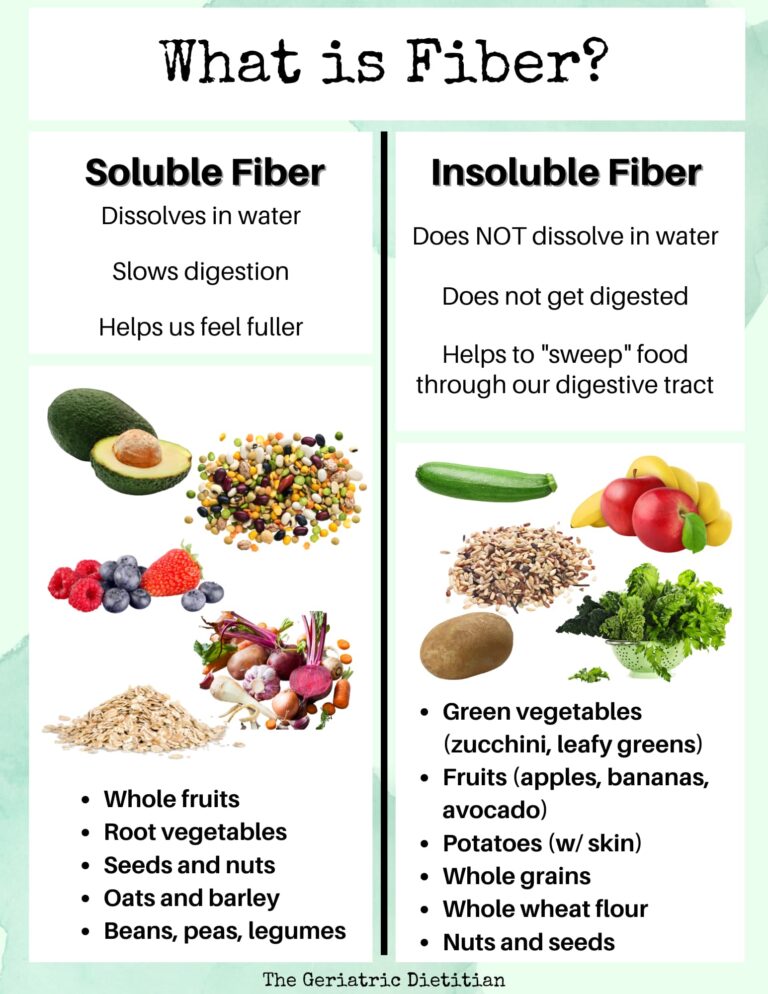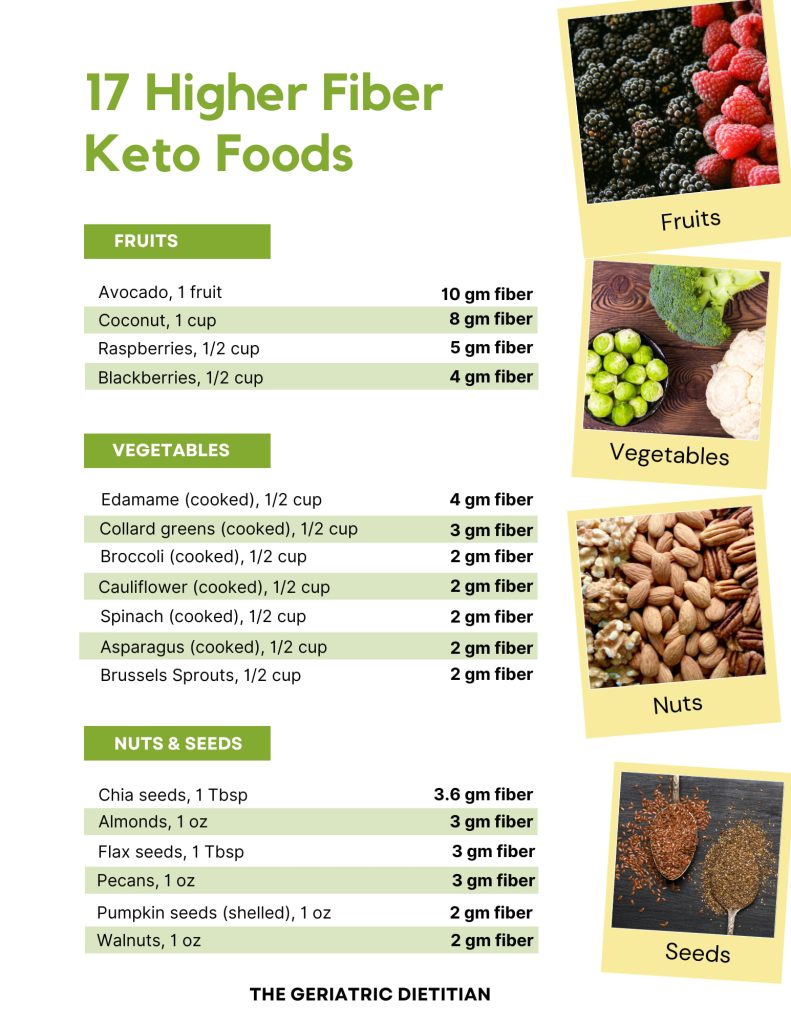“Incorporating Higher Fiber Keto Foods Into Your Diet [Free PDF]” was written by Amber Lam, RD & edited/reviewed by Aly Bouzek, MS, RDN.
Keto Diet + Higher Fiber Keto Foods
The ketogenic, or keto, diet focuses primarily on eating high-fat, low-carbohydrate foods. There are a number of reasons people follow a keto diet:
- for weight loss
- managing type 2 diabetes (1)
- personal health choice (or as directed by your doctor or a registered dietitian)
- and many others
While this dietary plan can result in a number of health benefits, one common issue faced by many people following the keto diet is a lack of dietary fiber.
Thankfully, you don’t need to compromise — there are many higher fiber keto foods to add to your daily diet.
** Speak with your healthcare team before making changes to your diet. The keto diet is not for everyone and may exacerbate certain health conditions.
<< Jump to Higher Fiber Keto Foods to get your free PDF >>
What is Fiber?

We cover everything you could possibly want to know about fiber in our, High Fiber Foods 101: A Comprehensive Guide.
In case you haven’t had a chance to check out our guide above, we’ll explain a bit more about fiber here.
Fiber is a carbohydrate that our bodies aren’t able to digest. It’s found in plant-based foods, and pretty much enters and exists the body, mostly unaffected.
It comes in two types, soluble fiber and insoluble fiber, and both types of fiber are important for our health.
Fiber benefits include preventing constipation by adding bulk to your stool, and boosting your gut health. Let’s learn more below.
Importance of Higher Fiber Keto Foods
Fiber is a vital component of a balanced diet, playing an important role in supporting digestive health, controlling blood sugar levels, and maintaining a feeling of fullness after meals.
Unfortunately, many traditional sources of fiber, such as fruits, whole grains, and legumes, are also high in carbohydrates (which, if you remember from above, should be limited when following a keto diet).
This leads us to focus on lower carbohydrate sources of fiber – like those that come from plant and seed sources.
How Much Fiber Do We Need?
While fiber needs decrease slightly as we age, it is still an important nutrient to include in any diet.
The USDA’s Dietary Guidelines for Americans recommends these fiber amounts depending on age and sex:
| Fiber (grams per day) | |
| Women, 31 – 50 years old | 25 |
| Women, 51+ years old | 22 |
| Men, 31 – 50 years old | 31 |
| Men, 51+ years old | 28 |
While those numbers do not seem like a lot, if we are following a keto diet where the focus is to reduce carbohydrate intake, meeting our fiber needs can become a challenge.
Examples of Higher Fiber Keto Foods
Did you know that there are a variety of foods that are both high in fiber and keto-friendly? For instance, avocados are an excellent source of fiber, at 10 grams!
Chia seeds, flaxseeds, and hemp seeds are other fiber-rich sources that also offer a good dose of omega-3 fatty acids.
Many types of berries, such as blackberries and raspberries, have a high fiber content and a relatively low carbohydrate count.
- ½ cup blackberries provides 7.2 grams of carbs and 4 grams of fiber
- ½ cup raspberries provides 8.9 grams of carbs and 4.9 grams of fiber
To make it easier for you to select some higher fiber keto foods, we have created this list below. Simply choose one to incorporate into your regular keto meal, or swap out lower fiber keto foods for higher fiber keto foods.
17 Higher Fiber Keto Foods
Click the image or 17 Higher Fiber Keto Foods to get your free PDF!

- Chia Seeds
- Avocados
- Almonds
- Flaxseeds
- Broccoli
- Cauliflower
- Walnuts
- Blackberries
- Coconut
- Edamame Beans
- Brussels Sprouts
- Spinach
- Asparagus
- Collard Greens
- Pumpkin Seeds
Incorporating Higher Fiber Keto Foods
Many of the foods listed above are great not only for their fiber content, but their versatility.
Smoothies
A keto-friendly smoothie that is also high in fiber can be made by combining berries, avocados (for creaminess), chia seeds, and almond milk.
Below are 3 fiber-rich keto-friendly smoothies that can easily fit into your diet. All can be made by combining all ingredients in a blender, blend until smooth, and enjoy!
Avocado-Berry Smoothie
Ingredients:
1/2 ripe avocado (5 grams fiber)
1/2 cup blueberries (1.8 grams fiber)
1 cup unsweetened almond milk
1 tablespoon chia seeds (3.6 grams fiber)
Sweetener of choice (optional)
Chia Seed & Spinach Smoothie
Ingredients:
1 cup spinach (0.7 grams fiber)
1 cup unsweetened almond milk
1 tablespoon chia seeds (3.6 grams fiber)
1 tablespoon flaxseeds (3 grams fiber)
1 scoop of your favorite keto-friendly protein powder
Sweetener of choice (optional)
Almond & Coconut Smoothie
Ingredients:
1 cup unsweetened almond milk
1/4 cup unsweetened shredded coconut (4.5 grams fiber)
1 tablespoon chia seeds (3.6 grams of fiber)
1 scoop of your favorite keto-friendly protein powder
Sweetener of choice (optional)
Each of these smoothie recipes is packed with fiber, healthy fats, and other vital nutrients, making them a perfect addition to your keto meal plan.
Salads

Add chia seeds or flax seeds to your usual keto meal by sprinkling a tablespoon on top of a fresh salad or by adding the seeds to a dressing for added crunch.
Avocados, as mentioned above, are loaded with fiber, and are an excellent addition to any keto-friendly salad.
The creamy texture and mild flavor blend seamlessly with other salad ingredients.
Spinach is not only a good source of fiber but also packed with essential vitamins and minerals. Use spinach as the base of your salad, replacing lower fiber lettuce varieties. Try adding a handful to your smoothies too!
As a Side Dish
Add higher fiber keto foods such as spinach, asparagus, Brussels sprouts, and artichokes to your favorite proteins. Here are some ideas:
- Roasted Brussels Sprouts: Brussels sprouts are a high-fiber, low-carb option that can be easily incorporated into a keto diet. Roasting them with a bit of olive oil, salt, and pepper makes for a delicious and fiber-rich side dish.
- Cauliflower Mash: Cauliflower is a versatile vegetable that’s ideal for a keto diet due to its low-carb content. You can make a high-fiber, mashed potato substitute by boiling and mashing cauliflower, then adding butter, cream, and seasonings.
- Zucchini Noodles: Zucchini is another low-carb, high-fiber vegetable that can easily be turned into a keto-friendly pasta alternative. Use a spiralizer or julienne peeler to create thin noodles, then sauté them with garlic and olive oil for a tasty side dish.
Key Takeaways
Whether you choose a keto diet or are required to follow one due to health concerns, a common issue faced is lack of dietary fiber.
With some planning and preparation, higher fiber keto foods can be included in your diet. Additionally, with the examples provided above, you can create your own high fiber meals and snacks.
We have also provided some specific meal ideas to help you increase the fiber content of your keto meals and snacks.
By carefully selecting and incorporating higher fiber keto foods into your daily regimen, you can enjoy the benefits of a keto diet while still ensuring your fiber intake is up to par.
Be sure to visit our article on High Calorie Keto Foods for Weight Gain if you are on a weight gain journey!
Remember, everyone’s dietary needs and tolerances are different; it’s always important to listen to your body and consult with a healthcare professional before making significant changes to your diet.
